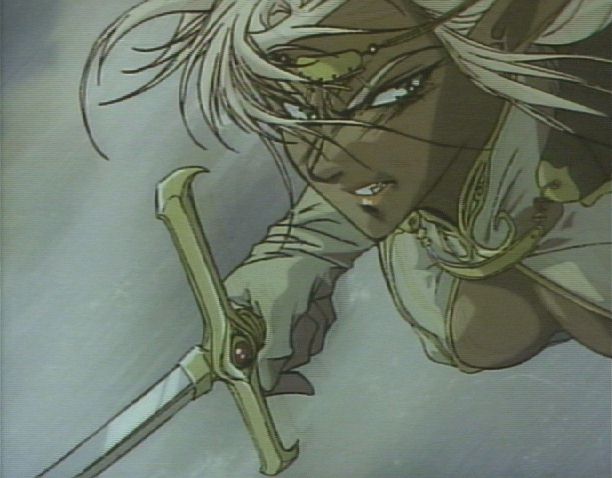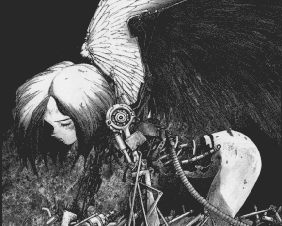![]()
![]()
anime
animé
Japanimation
What Is Anime?
The term anime refers to a distinctive tradition of Japanese animation that is almost immediately recognizable by its superior artistic quality as well as by the somewhat mannered artistic conventions anime artists employ, such as the preference for child-like, large eyes. But it's not just the art that grabs one's attention.
In contrast to the flat, Good vs. Evil plots in U.S. cartoons, many anime stories deal with complex, thought-provoking themes, presenting complex characters that change as the stories progress. There's a ready acceptance of the reality of death. In some anime, even those intended for kids, main characters sometimes die. Although there's as much silliness and trash in anime as in any other popular medium, it's a fair generalization to say that it's a more intelligent genre than American cartoons. For anyone used to Disney's predictable plots and platitudes, one's first encounter with anime produces shock, followed by fascination. It's serious stuff.
Anime also provides a window into another culture. In ways that many anime fans scarcely guess, anime draws strongly from Japanese and wider Asian mythology and symbolism generally, and specifically from the rich Japanese traditions of Shinto, the martial arts, and Zen.
 Perhaps
that's one of the reasons anime deals so successfully with fantasy themes,
as fans of Record of the Lodoss War, illustrated here, will readily
attest. But there's more.
Perhaps
that's one of the reasons anime deals so successfully with fantasy themes,
as fans of Record of the Lodoss War, illustrated here, will readily
attest. But there's more.
Responsible for some of the world's best technology at present, the Japanese seem to be out in front in another way, too: Thinking seriously about the implications of advanced technology.
 Some of
the most interesting anime explore the implications of technologies that
blurs the distinctions between machine and person, male and female, good
and evil, leaving the characters groping to find their moorings. In contrast
to American explorations of advanced technology (as in Star Wars and
the Terminator films), which subsume all the issues under the "absolute
good vs. absolute evil" and "happy ending" tropes, anime
deeply explores the moral and spiritual ambiguities of life and culture
in a world pushed over the edge by rampaging technological progress.
Some of
the most interesting anime explore the implications of technologies that
blurs the distinctions between machine and person, male and female, good
and evil, leaving the characters groping to find their moorings. In contrast
to American explorations of advanced technology (as in Star Wars and
the Terminator films), which subsume all the issues under the "absolute
good vs. absolute evil" and "happy ending" tropes, anime
deeply explores the moral and spiritual ambiguities of life and culture
in a world pushed over the edge by rampaging technological progress.
What Are Manga?
Anime is closely related to Japanese comics, called manga: Many anime series got their start as popular manga. An industry with $3 billion annual sales in Japan, manga account for as much as 60 percent of all printed materials sold in that country, and are very avidly read--so much so, in fact, that addiction is something of a problem. Japanese smile wryly when they refer disparagingly of otaku, over-the-top manga fans whose filthy, cluttered homes are stacked to the rooftop with manga. (For more information on manga, see rec.arts.manga: Frequently Asked Questions.)
The popularity of manga helps to explain why anime productions values are so high: It's a huge, profitable market. A recent anime feature release, The Wings of Honneamaise, reportedly cost $8 million to produce, and involved the efforts of more than three thousand animators. Some of Japan's most talented artists and musicians are drawn to the manga/anime industry. (For more information on anime and manga in print-based media, see Anime and Manga: A Resource Bibliography.)
How Is Anime Distributed?
In Japan, anime appears in three media: TV series (often running several years, and accumulating several dozen episodes), Original Animation Video (OAVs, also spelled OVA), and full length feature films. The first Japanese anime TV show, "Tetsuawan Atom" ("The Mighty Atom"), debuted in 1963 and ran for 10 years. Millions of American kids saw it as "Astro Boy." (For an interesting timeline of anime TV series, see History of Television Anime.)
In the U.S., anime videos are available in VHS and Laserdisc formats. Anime is also sometimes shown on the Sci-Fi network.
TIP: As you'll quickly learn, some anime videos available in the U.S. are available in a subtitle version (English subtitles, Japanese audio) or a dubbed version (English voice-over). Anime fans greatly prefer the subtitled versions, and for a number of reasons: Sometimes the dubbing isn't quite in synch with mouth movements, the spoken (and sung) Japanese is part of the cross-cultural experience and charm of anime, and (not in the least) many anime fans are learning a little Japanese!
For parents, the subtitled/dubbed decision isn't quite so simple. Young children may have trouble following the subtitles--they flash on and off the screen at a decidedly adult reading pace. For preschoolers and elementary-school-aged kids, the dubbed titles have their advantages.
Why Is A Parent's Guide to Anime Needed?
Some anime are expressly designed for children, and some can be enjoyed by the entire family. Others--including many series originally broadcast on Japanese television--contain material that some parents will find objectionable, even though other parents wouldn't hesitate to share these videos with their kids. And some are explicitly designed for adult audiences and shouldn't be shared with children.
Another point parents should bear in mind about anime is that, in Japanese culture, casual nudity isn't considered to be harmful to children. Many quite innocent anime videos, designed for broadcast on Japanese TV, contain brief nudity in non-sexual situations (for example, in public baths, which are very much part of traditional Japanese culture). Non-Japanese parents will need to decide for themselves whether this content is appropriate for their children.
Unlike American animated films intended for children's audiences, anime tends to deal much more realistically with evil and death. The classic American villain--wholly evil, and not very believable--gives way to complex characters with whom one can partly sympathize. Anime is often thought-provoking and provides an excellent foundation for raising important issues with your children.
What about gender and sex roles? Parents should realize that Japan isn't as "liberated" as the U.S. with respect to the presence of women in the professions, and some anime reflect this and portray women in traditional, submissive roles. This isn't necessarily a liability; evidence of this difference could provide an occasion for discussing cultural differences and historical change with your kids. On the whole, though, anime authors are probably more liberal than Japanese society, and one finds many anime with strong, independent female characters. The best anime transcend stereotypes by exploring the complexity of characters' emotions regarding relationships. For a thoughtful discussion of this issue, see Eri Izawa's "Gender and Gender Relations in Manga and Anime" .
An Invitation
Hilarious, charming, thought-provoking, enchanting, and sometimes deeply moving--these are some of the adjectives that spring to mind in recalling the best anime. To share anime with one's children is to invite them to experience some of the most beautiful artistic works you'll find anywhere, as well as lots of flat-out fun. Please start with My Neighbor Totoro, a heartbreakingly beautiful tribute to the fast-disappearing Japanese countryside--and to the redemptive power of a family's love.
Anime seems to function very effectively as a cultural ambassador. Many families who watch anime find that their children fall in love with Japan and the beautiful Japanese language. Both of my children are studying martial arts and Japanese, and hope to travel to Japan someday and make Japanese friends.
We would like to honor and thank all the people in the anime industry, both in Japan and the U.S., who make it possible to share these wonderful treasures with our families.
- text by Bryan Pfaffenberger
[ << prev ] [ top ] [ next >> ]
[ home ]
[ what's new ]
[ café contest ]
[ café reviews ]
[ parent's guide ]
[ encyclopædia ]
[ café trivia ]
[ café latté ]
[ café espresso ]
[ about the café ]
[ feedback ]
[ links ]
[ site map ]
© 1997-2000. All rights reserved. The Animé Café logo and the Crystal Kyoko award are original creations of the Animé Café. Please do not use any of the materials on this site without the expressed written permission of the Animé Café.
Page last modified 1999.10.21
